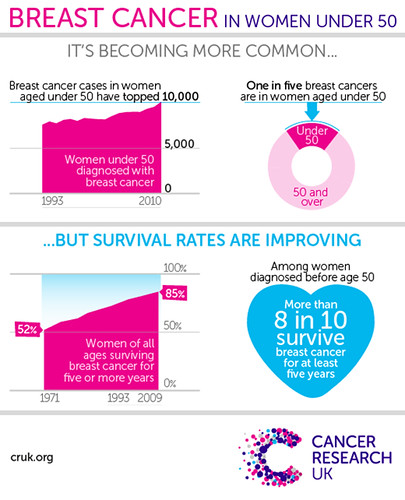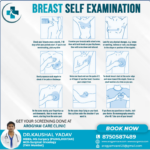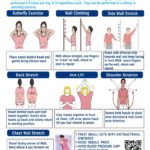Breast Cancer
Breast are milk producing specialized glands in women. Lymph vessels carry a clear fluid called lymph into the small bean-shaped structures which contain immune cells called lymph nodes. Breast Lymph vessels drain into the lymph nodes in axilla. Although rare but breast cancer can develop in males also.
Breast cancer is the cancer arising from the cells of the breast. Malignant tumors are the tumor which have potential to invade other tissues and spread to other organs of the body. It’s important to understand that most breast lumps are benign means they grow inside breast tissue and do not spread to other parts of the body.
Breast cancer is most common cancer and the most common cause of cancer related mortality in Indian females.
 “Breast Cancer Cases in Women aged under 50” by DES Daughter is licensed under CC BY-NC-SA 2.0[/caption]
“Breast Cancer Cases in Women aged under 50” by DES Daughter is licensed under CC BY-NC-SA 2.0[/caption]
Types
Non Invasive Breast Cancer:
- Ductal carcinoma in situ (DCIS): This is a non-invasive type of breast cancer, meaning it stays within the ducts and does not spread. It is sometimes called a pre-cancer because it can develop into invasive cancer if left untreated.
- Lobular carcinoma in situ (LCIS): This is also a non-invasive type of breast cancer, meaning it stays within the lobules and does not spread. It is not considered a true cancer, but rather a risk factor for developing invasive cancer in the future.
Invasive Breast Cancer:
- Invasive ductal carcinoma (IDC): This is the most common type of breast cancer, accounting for about 80% of all cases. It starts in the cells lining the ducts and can spread to other parts of the breast or other organs.
- Invasive lobular carcinoma (ILC): This type accounts for about 10% of all cases. It starts in the cells of the lobules and can also spread to other parts of the breast or other organs. Invasive lobular carcinoma is a risk factor for bilateral breast cancer.
Inflammatory breast cancer: This is a rare and aggressive type of breast cancer that causes the breast to become red, swollen and inflamed. It accounts for about 1-5% of all cases.
Paget’s disease of the nipple: This is a rare type of breast cancer that affects the skin of the nipple and the areola (the dark circle around the nipple). It accounts for about 1-4% of all cases.
Angiosarcoma: This is a very rare type of breast cancer that starts in the blood vessels or lymph vessels of the breast. It accounts for less than 1% of all cases.
- Other types: like mucinous, mixed & phylliod carcinoma
Risk Factors
- Age –Mostly beyond 50 years. There is increase in number of breast cancer cases in 30-40 years age group in India.
- Gender – Being female is a risk factor for breast cancer.
- Genetic – Women who have certain mutations in the BRCA1 and BRCA2 genes have a higher chance of developing breast cancer, ovarian cancer, or both.
 “The Inherited Risk of Breast and Ovarian Cancer” by DES Daughter is licensed under CC BY-NC-SA 2.0[/caption]
“The Inherited Risk of Breast and Ovarian Cancer” by DES Daughter is licensed under CC BY-NC-SA 2.0[/caption] - Family History – If any woman in a family is having Breast cancer, then it increases the risk of other individuals in the family.
- Obesity/ Overweigh
- Menstrual History –Having first period before age 12 and late menopause increases the risk of breast cancer.
- Pregnancy –Never been pregnant is a risk factor for breast cancer. Also first child birth after 35 years increase the risk compared to early child bearing.
- Alcohol
- Hormone replacement therapy for longer periods
- Radiation exposure
- Certain Benign breast diseases like atypical ductal or lobular hyperplasia
- First Pregnancy before 30 years, Breast feeding, physical activity are considered as protective factors.
Screening for Breast Cancer:
1) Mammography –American cancer society recommend mammography for screening:
- Women 40-44 years: start screening with yearly mammogram..
- Women 45- 54 : should get mammograms every year.
- Women ≥ 55: mammogram every other year, or they can continue yearly mammograms and should continue as long as health is good.
For persons with high risk Screening is recommended to start early and more frequently with advise from treating doctor.
2)Breast Self Examination: advised to detect any small lump or change which could be sign of early breast cancer. It is easy to learn and any abnormality should be reported to the oncologist.
Method –
- It is done with palm of figures in rolling motion in all parts of both breasts. Can be done at the time of bathing/ shower.
- Stand in front of the mirror with both arms by the side of the body
- Look in front of the mirror with both arms over the hips
- Look in front of the mirror with both arms above head
- Feel Behind the nipple
3)MRI : advised in genetically predisposed/ very high risk individuals starting at younger age.
Alarmimg Signs of Breast Cancer
Lump – most common symptom. Lump mostly appear in breast but it can be in axilla/ armpit because of lymph nodes.
Dimpling on the breast
Sunken or inverted nipple
Redness or scaling of the skin of the breast, nipple or areola.
Discharge from nipples especially if blood stained.
Pain or ulcer over tumor
Symptoms due to spread in other organs like weight loss, bony pain, headache breathlessness.
If you notice any of these symptoms, do not panic, but do not ignore them either. Most breast lumps or changes are not cancerous, but it is always best to have them checked by a doctor as soon as possible. Early detection and treatment can improve your chances of survival and recovery. Breast cancer is not a death sentence. With advances in diagnosis and treatment, many women can live long and healthy lives after being diagnosed with breast cancer. The key is to be aware of your breasts and any changes that may occur, and to seek medical attention if you have any concerns.
Investigations
Treatment
Surgery; – Mainstay of curative treatment. Following surgeries are done to cure breast cancer-
- Wide Excision/ Lumpectomy :Tumor along with normal surrounding tissue is excised. Sufficient for benign tumours of the breast. Benign phylloid tumours require a much wider resection margin of 2-3 cm.
- Simple Mastectomy :A Breast tumor along with whole breast tissue and nipple areola are excised. Axilla is not addressed in this surgery. Usually done for ductal carcinoma in a situ and phylloid tumor.
- Modified Radical Mastectomy :Breast with a tumor at appropriate margins and nipple-areola complex is excised along with axillary lymph node dissection. 10-15 axillary lymph nodes are considered adequate as per the guidelines. All stations of lymph nodes (I-III) suspected of having lymph nodes should be excised. Most commonly done surgery for breast cancer.
- Breast Conservation Surgery :As the understanding of tumor biology is increasing and as the technologies are increasing, oncology surgery has improved to provide more and more functional results. Patient sections play’s a very important role. A suitable tumor with surrounding breast tumor with negative margins is excised. Axillary lymph nodes are removed as standard.
Certain Recent Advances includes:
- Sentinel Lymph Node Biopsy: Sentinel lymph node is the first draining level lymph node of a breast tumors. Usually, a radioactive dye is injected around a tumor before surgery and blue dye is injected in breast tissue at the time of surgery. Gamma camera probe is used to identify the radioactivity and targeted node identified. It is excised and sent for the frozen section during surgery. If tumor cells are absent, then there is no need to address higher axillary lymph nodes. If tumors cells are identified than complete axillary surgery is done.
- Skin Sparing Mastectomy and immediate breast reconstruction: Preserve normal body image.
To Book Appointment for Cancer Surgery :
Integration of Multimodality Treatment
Chemotherapy :Chemotherapy serves three major purposes –
As Adjuvant therapy for good long term control after surgery.
As Neo-adjuvant therapy :given before surgery in locally advance disease to control micrometastasis and decrease tumor.
As Palliative in metastatic disease whencancer has spread to other parts of the body. Chemotherapy now provides a meaningful control even in stage IV disease.
Hormone threrapy : used in hormone receptor positive cases I.e. ER+/ PR +
Targetted therapy : in cases which having postive specific targets like Her2+
Radiation Therapy

Got some questions
- If all relavant examination and investigations has been done than plan of treatment is finalized with colon cancer surgeon
- After deciding surgical procedure cost estimate can be taken from billing department or hospital. Clinic or hospital department coordinator will assist in case any help required. +918750587489,
- you can visit nearby hospital for colonoscopy screening as advised in our screening section or you can read various society guidelines like American cancer society, USPTF.
- You can consult us through our online consultation link. https://api.whatsapp.com/send/?phone=918750587489&text=I+am+Looking+for+an+appointment+with+Dr.+Kaushal+Yadav.+Please+Help&type=phone_number&app_absent=0





